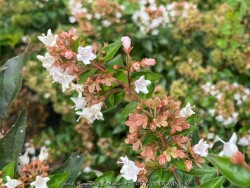

Raspberry Profusion Abelia (Abelia chinensis 'Raspberry Profusion') is a compact rounded, spreading, multi-stemmed shrub in the honeysuckle family. Typically grows on gracefully arching branches to 2-4' tall. 'Raspberry Profusion', a seedling selection of 'Edward Goucher' x chinensis, blooms heavily from May to September. The entire plant is covered with big clusters of strongly-scented, pink flowers with flamboyant raspberry sepals. The sepals remain after the flowers drop, extending the color until the end of autumn. New growth emerges glossy red and ages to a handsome dark green. The shrub is robust and compact, growing to 3-4' tall and wide. It is mostly deciduous in the winter. Semi-evergreen dark green leaves turn purplish-bronze in autumn persisting until 10 degrees F or so. Wood is hardy to 0 degrees F. In years where the stems die to the ground in winter but the plant survives, flowering will still occur on new growth. 'Raspberry Profusion' Abelia (Abelia chinensis 'Raspberry Profusion') is an unusually hardy abelia, thriving even in zone 5b. Abelia is also known for it's fragrant flowers that attract butterflies and hummingbirds, plus it's shade-tolerant and resistant to both deer and rabbits. Graceful, arching habit makes it a perfect choice for late season fragrance in your landscape.
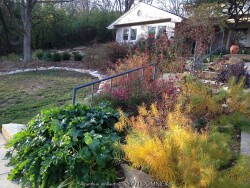

Bear's Breeches / Acanthus is a clump-forming perennial that is grown as much for its attractive dark green foliage as for its architecturally bold flower spikes. It is native to the Mediterranean region. Flowers are creamy white (sometimes pinkish) and snapdragon-like. Foliage is mostly evergreen in warm winter climates, but plants lose their leaves when winter temperatures dip below 20°F. Foliage is usually persisting until mid-early December in Kansas. If low temperatures hit -10 degrees F, it may kill an un-mulched plant; protect any zone 6 perennial with thick layer of mulch. Established plants survived -16 degrees F and a week of single digit highs in February, 2021. Acanthus may be grown a potted patio plant for full to part shade. Grown in a raised pot, they are hardy to about 15-20° so you may be able to miss the first few frosts when moving them in for the winter. Before extreme cold, overwinter in a dark garage or basement with monthly watering to encourage dormancy. Alternatively, it can maintain growing in a bright window as a houseplant. Either way, they will hold up very well in the winter and maintain their attractive foliage. In spring, just cut off dead foliage and place back out in April or May with a time-release fertilizer.
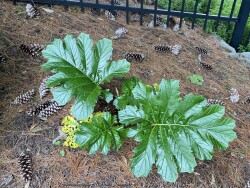

Bear's Breeches / Acanthus is a clump-forming perennial that is grown as much for its attractive dark green foliage as for its architecturally bold flower spikes. It is native to the Mediterranean region. Flowers are creamy white (sometimes pinkish) and snapdragon-like. Foliage is mostly evergreen in warm winter climates, but plants lose their leaves when winter temperatures dip below 20°F. Foliage is usually persisting until mid-early December in Kansas. If low temperatures hit -10 degrees F, it may kill an un-mulched plant; protect any zone 6 perennial with thick layer of mulch. Established plants survived -16 degrees F and a week of single digit highs in February, 2021. Acanthus may be grown a potted patio plant for full to part shade. Grown in a raised pot, they are hardy to about 15-20° so you may be able to miss the first few frosts when moving them in for the winter. Before extreme cold, overwinter in a dark garage or basement with monthly watering to encourage dormancy. Alternatively, it can maintain growing in a bright window as a houseplant. Either way, they will hold up very well in the winter and maintain their attractive foliage. In spring, just cut off dead foliage and place back out in April or May with a time-release fertilizer. Acanthus mollis 'Wofford Rhubarb' features beautiful red leaf stalks.
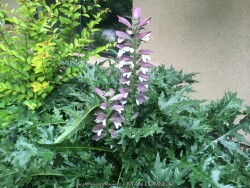

Spiny Bear's Breeches (Acanthus spinosus) is a clump-forming perennial that is grown as much for its attractive dark green foliage as for its architecturally bold flower spikes. The foliage of this species deeply cut and rather spiny looking dark-green leaves without actual spines. Flowers are creamy white (sometimes pinkish) and snapdragon-like and DO have sharp spines! It is the most thistly-looking of any of the various forms available. Foliage is mostly evergreen in warm winter climates, but plants lose their leaves when winter temperatures dip below 20°F. Foliage is usually persisting until mid-early December in Kansas. If low temperatures hit -10 degrees F, it may kill an un-mulched plant; protect any zone 6 perennial with thick layer of mulch. Established plants survived -16 degrees F and a week of single digit highs in February, 2021.
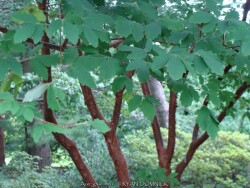

Paperbark maple (Acer griseum) is a small, deciduous, oval to oval-rounded tree with slender upright branching. It features exfoliating copper orange to cinnamon reddish/brown bark and showy orange to red fall color. Used in Kansas landscapes as an understory tree needing rich, moist soils. Even with ideal growing conditions, growth is slow.
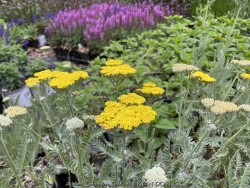

Coronation Gold Yarrow (Achillea 'Coronation Gold') is a vigorous tall growing yarrow with large golden-yellow flower heads. This non-reseeding variety blooms all summer and is considered to be one of the best yarrows for tolerating high humidity. It thrives when planted on a berm with heat and sun in poor soils including clay. Avoid rich soil, excessively windy sites, and too much irrigation.
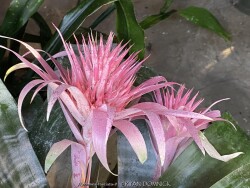

Silver Vase / Urn Plant (Aechmea fasciata) is an exotic-looking flowering plant from the bromeliad (Bromeliaceae) family. Despite its exotic appearance and tropical nature, this bromeliad adapts well to living as a potted house plant. In Kansas, use as a summer patio plant and protect from direct sunlight in mid summer and any temperatures below 50 degrees F in the spring or fall. As an epiphyte, much of its water needs are met by keeping the plants center "Urn" filled with water once per week or two. They have a shallow root systems and probably won't ever need repotted. When flowering, the flowers themselves are short-lived, but the pink and red bracts last for a few months.
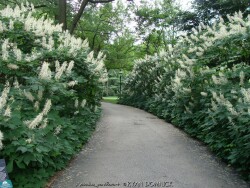

This species (Aesculus parviflora) grows as a large suckering deciduous shrub in evenly moist, well-drained soils in part shade to full shade. The species is native to the southeastern United States, where it is found primarily in Alabama and Georgia but is hardy much further North to zone 5. Useful in Kansas landscapes in rich established forest areas or along stream banks with plenty of room. Tends to thrive in rich forest soils of Eastern Kansas just fine without irrigation but is not known to tolerate moderate to drought. Bottlebrush buckeye features large palmate green leaves and tall cylindrical panicles (to 12" long) of tubular white flowers with conspicuous red anthers and pinkish filaments. Mid-summer bloom will not go unnoticed!
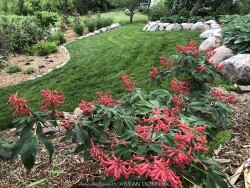

Red Buckeye (Aesculus pavia) is a valuable small tree or shrub is native to the southern and eastern parts of the United States. Grow in average, medium moisture, well-drained soil in morning sun to full shade. In Kansas, growth is slow but flowers at a very young age when only a couple feet tall making it useful as a flowering shrub for the first 10-20 years. Then you can allow it to grow into a small tree. Tall ruby red flowers bloom for about a month close to redbud bloom timing and hummingbird migration back to the area. Attractive brown fruits are produced in August/September and are favored by squirrels as their first fall nut crop. Foliage is dropped rapidly making it one of the first shrubs or trees to drop its leaves sometimes as early as late September. This is rarely a problem though, as there are many other things happening in the garden in the fall.
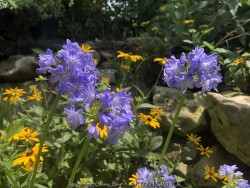

Agapanthus are typically grown in warmer zones, but Walters Gardens has introduced a collection of vigorous varieties that are hardy to zone 6! Agapanthus 'Galaxy Blue' was originally tested in Michigan and overwintered for the more than 7 years. They also survived the Kansas cold blast of February 2021 (temperatures reaching -16 degrees F) with no problems. They're out of this world with globular clusters that are produced on tall stems over large, rounded clumps of foliage. 4" clusters of dark blue flowers are produced and rebloom occurs if watered regularly in the summer. True blue is an especially rare flower color in the garden. Foliage resembles daylilies and turns yellow in the fall. To be safe with any "hardy tropical", apply a heavy 3-4"mulch layer for the first few years.
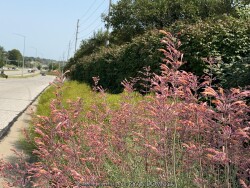

Sunset Agastache (Agastache rupestris) is a cold hardy, native hybrid perennial that blooms from mid to late summer and sporadically into the fall. This variety features a profusion of orange and pinkish flowers that attract hummingbirds and bumblebees. Both the flowers and foliage have a strong minty licorice scent when touched, and aromatic foliage helps to deter both deer and rabbits. Having desert heritage, it resents poor drainage and winter moisture. To counteract that in Kansas, plant in full sun on berm with poor sandy or rocky soil with no irrigation.
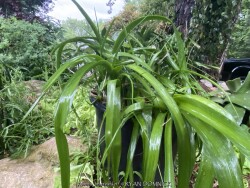

Pregnant Onion (Albuca bracteata) is typically grown in warmer zones. Considered a tropical or succulent in Kansas and used as summer patio plants with white flowers and bright green foliage. Be prepared to give away offset bulblets to all your friends! Water sparingly and place in full sun to mostly shade. Pregnant Onion can tolerate frost but protect from temperatures below 25 degrees F and move into a cold garage or basement over the winter with minimal watering. Do not allow the pot with rootball to freeze solid or go below 23 degrees for more than a few hours. Allow to go dormant with little care, just cut off dead foliage and place back out in April or May with a time-release fertilizer. Repotting may or may not be needed depending on how large you want the plant to grow; plants can continue to grow taller and tolerate extremely root-bound pots but may need wind bracing. If repotting, make sure to use a sharp draining medium organic cactus mix with plenty of sand and perlite.
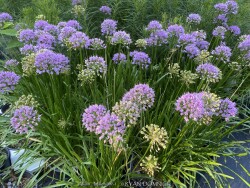

Millenium Ornamental Onion (Allium 'Millenium') is among the best of the ornamental onions. This award-winning perennial produces a compact clump of glossy green leaves. Bright rosy purple, rounded flower clusters appear on strong stems just above the foliage. Unlike spring-blooming Allium bulbs, 'Millenium' blooms in mid-summer. The attractive, shiny deep-green grassy foliage is very ornamental and lasts all season including winter interest in Kansas. Grow in just about any soil including heavy clay in full to part sun. In Eastern Kansas, typically our 40 inches of rainfall is sufficient without extra water. And as with all alliums, these are completely rabbit proof. Considered a "Once it's there, it's there forever" plant!


Serendipity Ornamental Onion (Allium 'Serendipity') is among the best of the ornamental onions. This award-winning perennial produces a compact clump of glossy blu-green leaves. Bright rosy purple, rounded flower clusters appear on strong stems just above the foliage. Unlike spring-blooming Allium bulbs, 'Serendipity' blooms in mid-summer. The attractive, shiny deep-green grassy foliage is very ornamental and lasts all season including winter interest in Kansas. Grow in just about any soil including heavy clay in full to part sun. In Eastern Kansas, typically our 40 inches of rainfall is sufficient without extra water. And as with all alliums, these are completely rabbit proof. Considered a "Once it's there, it's there forever" plant!
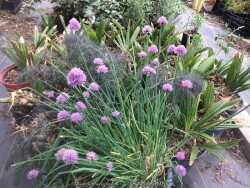

Chives (Allium schoenoprasum) are an easy to grow edible and ornamental perennial. Attractive, globular, clover-like clusters of pale purple flowers appear in spring and early summer. Grow in just about any soil including heavy clay in full to part sun. In Eastern Kansas, typically our 40 inches of rainfall is sufficient without extra water. And as with all alliums, these are completely rabbit proof. Considered a "Once it's there, it's there forever" plant!
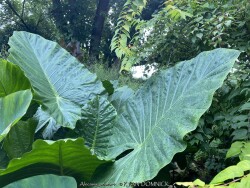

Odora Elephant Ear (Alocasia odora) is typically grown in warmer zones and features giant glossy green leaves creating quite a contrast for other colorful flowers in the garden. Most alocasia are large tropical and subtropical herbaceous perennials with a giant tubers native to areas with a summer monsoon and dry winter. Along with other tropicals and succulents in Kansas, elephant ears are usually grown as summer patio plants. Fertilize, water regularly, and place in full sun. Protect from temperatures below 28 degrees F and move into a cold garage or basement over the winter with minimal watering. Do not allow the pot with rootball to freeze solid or go below 25 degrees for more than a few hours. Allow to go dormant as needed with little care, just cut off dead foliage and place back out in April or May with a time-release fertilizer. Many plants will die back slowly and remain attractive inside for most of the winter. You may also plant these in the ground for an enormous tropical effect! It is possible to overwinter these in the ground in Kansas by placing a giant 12-18" mound of mulch over deeply planted rhizomes. New growth will usually be delayed until June but quickly regains full height. In our trial gardens in Lawrence, KS (zone 6a), three established specimens planted over 12" deep and mulched 6-12" with leaf mulch survived -17 degrees F. During the arctic blast of February, 2021, lows down to -17 degrees F on Feb 16th, 2021 were recorded. The longevity of this cold blast was also impressive: 10 days on a row with highs of 10-15 degrees F or lower, 8 nights of lows in the single digits and negatives, and 36 strait hours of 0 degrees F and mostly lower.
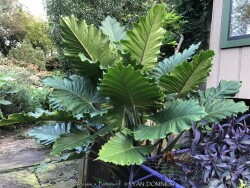

Portora Elephant Ear (Alocasia x Portora) is typically grown in warmer zones and features giant glossy green leaves creating quite a contrast for other colorful flowers in the garden. Most alocasia are large tropical and subtropical herbaceous perennials with a giant tubers native to areas with a summer monsoon and dry winter. Along with other tropicals and succulents in Kansas, elephant ears are usually grown as summer patio plants. Fertilize, water regularly, and place in full sun. Protect from temperatures below 28 degrees F and move into a cold garage or basement over the winter with minimal watering. Do not allow the pot with rootball to freeze solid or go below 25 degrees for more than a few hours. Allow to go dormant as needed with little care, just cut off dead foliage and place back out in April or May with a time-release fertilizer. Many plants will die back slowly and remain attractive inside for most of the winter. You may also plant these in the ground for an enormous tropical effect! It is possible to overwinter these in the ground in Kansas by placing a giant 12-18" mound of mulch over deeply planted rhizomes. New growth will usually be delayed until June but quickly regains full height. This plant can also grow in standing water or as a potted plant in water gardens.
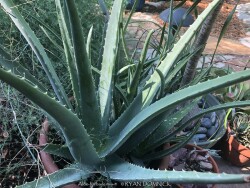

Giant Aloe is typically grown in warmer zones. Considered a tropical or succulent in Kansas and used as summer patio plants with white flowers and bright green foliage. Be prepared to give away offsets to all your friends! Water sparingly and place in mostly shade followed by full sun after acclimated. Giant Aloe can tolerate frost but protect from temperatures below 25 degrees F and move into a cold garage or basement over the winter with minimal watering. Do not allow the pot with rootball to freeze solid or go below 25 degrees for more than a few hours. It is important to avoid the combination of wet and cold. As a winter house plant, it will look presentable all winter long with just no waterings. As a permanent house plant, provide bright light and allow the soil to dry between waterings for many years of carefree enjoyment. Plants grown permanently indoors may begin to elongate stretching for light producing weak new growth. It can be hard to reproduce the intense UV sunlight they need so moving outside for the summer is best.Generally if moving outside for the summer, allow 3-4 weeks of part shade or morning sun before placing in full sun. Giant aloe is one of the slowest plants to re-acclimate to bright sunlight so this might take a month or so of protecting from full sun. Potted plants are very low maintenance. Division and re-potting will need to eventually occur as plants will get top heavy and offsets will fall out. I have never seen any insect problems on this plant. Survives each year a a long lasting annual in out display garden until about 18-20 degrees...usually into December before it looks damaged and unsightly.
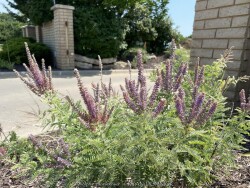

Leadplant (Amorpha canescens) is a small, deciduous perennial semi-shrub, 1-3 ft. tall, with tiny, purple flowers grouped together in colorful, terminal spikes with orange pollen. The blooming season is relatively short but the pinnately compound leaves offers lasting interest and a "Wow" factor. Leadplant can be found in many locations throughout North America but mostly in the midwest USA. Disjunct populations also exist in Texas, New Mexico and Colorado but skipping the fire-prone areas of the Great Plains. Leadplant is typically found in dry prairie pockets of land that are not overgrown, do not burn frequently, and experience minimal live-stock grazing. Leadplant grows best in drier, well-drained soil of many different textures including sandy, gravely, and rocky soils. Leadplant needs full sun for flowering and to avoid floppiness. Mainly used in Kansas landscapes in native prairie gardens, it tolerates considerable drought and alkaline limestone clay soils. It does best on a berm with great drainage or un-irrigated parking lot islands and "hell-strips". Leadplant has only one pest problem and that is rabbits! If rabbits are an issue, just put a bowl-shaped chicken wire cage around the plants for the first year. By year #2, the rapidly growing foliage will outgrow any detrimental rabbit browsing. This is definitely one of the most adapted native landscape shrubs in Kansas zone 6a with no problems with heat, cold, or drought! It's hard to imagine a native perennial garden without this plant! Butterflies will thank you!
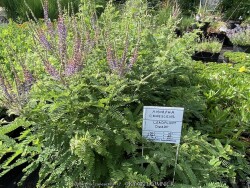

Leadplant (Amorpha canescens) is a small, deciduous perennial semi-shrub, 1-3 ft. tall, with tiny, purple flowers grouped together in colorful, terminal spikes with orange pollen. The blooming season is relatively short but the pinnately compound leaves offers lasting interest and a "Wow" factor. Leadplant can be found in many locations throughout North America but mostly in the midwest USA. Disjunct populations also exist in Texas, New Mexico and Colorado but skipping the fire-prone areas of the Great Plains. Leadplant is typically found in dry prairie pockets of land that are not overgrown, do not burn frequently, and experience minimal live-stock grazing. Leadplant grows best in drier, well-drained soil of many different textures including sandy, gravely, and rocky soils. Leadplant needs full sun for flowering and to avoid floppiness. Mainly used in Kansas landscapes in native prairie gardens, it tolerates considerable drought and alkaline limestone clay soils. It does best on a berm with great drainage or un-irrigated parking lot islands and "hell-strips". Leadplant has only one pest problem and that is rabbits! If rabbits are an issue, just put a bowl-shaped chicken wire cage around the plants for the first year. By year #2, the rapidly growing foliage will outgrow any detrimental rabbit browsing. This is definitely one of the most adapted native landscape shrubs in Kansas zone 6a with no problems with heat, cold, or drought! It's hard to imagine a native perennial garden without this plant! Butterflies will thank you!
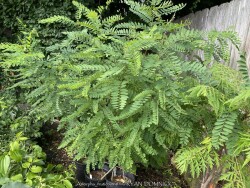

False Indigo Shrub (Amorpha fruticosa) is a 6-10 ft., loose, airy shrub which often forms dense thickets. The blooming season is relatively short but the pinnately compound leaves offers lasting interest and a "Wow" factor. The foliage is pinnately compound, fine-textured, and turns gold in the fall lasting for a week or two. Older plantings may be rejuvenated as they do develop a leggy character with the majority of their foliage on the upper third of the plant. This is a species of flowering plant in the legume family Fabaceae so it is able to make its own nitrogen. False Indigo Shrub tolerates many types of soil including wet sandy soils. Other names include desert false indigo, false indigo-bush, and bastard indigobush. It is native to North America and has potential to be invasive in parts of the country but not so much in Kansas.


***Description for this plant available with future update!*** >>>>> Plant Delights Nursery says "This little-known but easy-to-grow voodoo lily is native to the Yunnan Province of China. The stalks are either solid green or green with grey spots and are each topped with a glossy green leaf. Amorphophallus albus is a fast offsetting species that forms a nice 2' wide patch (in 5 years) in the woodland garden. In spring, just as the leaf emerges, a 1' tall flower stalk appears alongside it with a 6-8" tall flower perched on top. Each flower resembles a large ivory shell showcasing a white, cigar-like appendage...green at the tip and white at the base." >>>>>>>>>> Voodoo (Amorphophallus konjac) lily is a perennial tuber generally grown as a curiosity for its interesting foliage. The single leaf consists of a stalk (petiole) with mottled pinkish-gray and olive green coloration. The single intricate leaf has horizontal sections giving it a tropical umbrella-like effect. Larger tubers (about the size of a grapefruit or larger) may produce a single "flower" in spring before the foliage appears. The "flower" is actually a large shiny purple to maroon ruffled spathe. When in bloom it produces an odor like a dead animal for 1 day. This is intended to attract the carrion flies that are its natural pollinators. It is possible to overwinter these in the ground in Kansas by placing a 6-12" mound of mulch over deeply planted tubers. New growth will usually be delayed until June but quickly regains full height and will get bigger each year; buried tubers are hardy to zone 6a. They can also be grown as a flowering summer patio plant. If growing as a potted plant and trying to overwinter, allowing the foliage to frost is ok, it will not kill the root system. However, do not allow the pot with rootball to freeze solid or go below 20 degrees for more than a few hours; move into a cold garage or basement over the winter with no watering. Cut back and allow to go dormant and place entire pot back out in April or May with a time-release fertilizer. Plants can get huge and exotic looking as a potted patio plant. Grown in Japan and Korea as an edible corm.
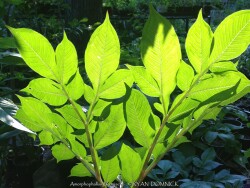

Voodoo (Amorphophallus konjac) lily is a perennial tuber generally grown as a curiosity for its interesting foliage. The single leaf consists of a stalk (petiole) with mottled pinkish-gray and olive green coloration. The single intricate leaf has horizontal sections giving it a tropical umbrella-like effect. Larger tubers (about the size of a grapefruit or larger) may produce a single "flower" in spring before the foliage appears. The "flower" is actually a large shiny purple to maroon ruffled spathe. When in bloom it produces an odor like a dead animal for 1 day. This is intended to attract the carrion flies that are its natural pollinators. It is possible to overwinter these in the ground in Kansas by placing a 6-12" mound of mulch over deeply planted tubers. New growth will usually be delayed until June but quickly regains full height and will get bigger each year; buried tubers are hardy to zone 6a. They can also be grown as a flowering summer patio plant. If growing as a potted plant and trying to overwinter, allowing the foliage to frost is ok, it will not kill the root system. However, do not allow the pot with rootball to freeze solid or go below 20 degrees for more than a few hours; move into a cold garage or basement over the winter with no watering. Cut back and allow to go dormant and place entire pot back out in April or May with a time-release fertilizer. Plants can get huge and exotic looking as a potted patio plant. Grown in Japan and Korea as an edible corm.
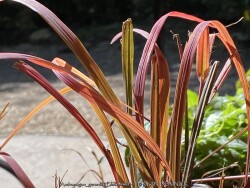

Big Bluestem (Andropogon gerardii 'Blackhawks') is easily grown in average, dry to medium, well-drained soils in full sun. It is tolerant of a wide range of soils and growing conditions but tends to flop in rich moist soils. This ornamantal grass is a tall, Kansas native, perennial, warm season grass that dominates much of the tall grass prairie extending into the Flint Hills. In fact, Big bluestem, Indiangrass, Little bluestem, and Switchgrass comprise 75% of the species in this ecosystem. It may be grown as an ornamental grass because of its attractive foliage which changes color seasonally along with its good architectural height and its interesting flower/seed heads. Andropogon gerardii 'Blackhawks' is primarily distinguished from the species by its slightly shorter height, deeper green summer foliage and blackish-purple fall color. An excellent garden performer with a clumping form and upright habit. Leaves emerge deep green with red highlights in spring, remain green through much of the summer, change to purplish-red to purple by late summer and finally turn a vivid scarlet red after first fall frost. Burgundy purple flowers bloom in August. Plants typically grow to 4-5' tall.


Big Bluestem (Andropogon gerardii 'Red October') is easily grown in average, dry to medium, well-drained soils in full sun. It is tolerant of a wide range of soils and growing conditions but tends to flop in rich moist soils. This ornamantal grass is a tall, Kansas native, perennial, warm season grass that dominates much of the tall grass prairie extending into the Flint Hills. In fact, Big bluestem, Indiangrass, Little bluestem, and Switchgrass comprise 75% of the species in this ecosystem. It may be grown as an ornamental grass because of its attractive foliage which changes color seasonally along with its good architectural height and its interesting flower/seed heads. Andropogon gerardii 'Red October' is primarily distinguished from the species by its slightly shorter height, deeper green summer foliage and brilliant scarlet red fall color. An excellent garden performer with a clumping form and upright habit. Leaves emerge deep green with red highlights in spring, remain green through much of the summer, change to purplish-red to purple by late summer and finally turn a vivid scarlet red after first fall frost. Burgundy red flowers bloom in August. Plants typically grow to 4-5' tall.
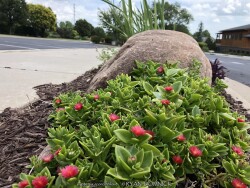

Red Apple Ice Plant (Aptenia / Mesembryanthemum cordifolia) is grown in Kansas as an annual or potted patio plant. Brilliant green glossy leaves contrast magenta flowers all summer! Plant in full sun with dry to average soil. In moist soils, this plant will grow rapidly and bloom less which may be good or bad. Flowers love the sun, but close up at night and remain closed on cloudy days. Plants will flower right up to frost and survive until a hard freeze of 23 degrees F is reached. If growing as a potted plant and trying to overwinter, watch out for scale and mealybugs. To discourage these pests, allow to go partially dormant and keep in a near freezing garage all winter. Cut back any old foliage and stems and place outside in mid-spring in full sun. These pests are never have time to establish in 1 growing season and are rarely a problem when actively growing as an annual in your landscape. Botanical name has recently changed to Mesembryanthemum cordifolium. Also known as Baby Sun Rose or Heartleaf Ice Plant. A variegated form is also available.
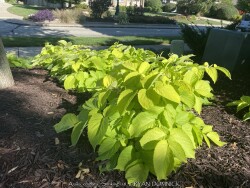

Sun King Aralia (Aralia cordata 'Sun King') is unique golden-leafed variety for the shade. The color will be brighter yellow and gold with pink leaf stalks in part sun, and more chartreuse or lime green in full shade. Tiny white flowers are insignificant and even a distraction to the gorgeous foliage. After blooming, deep purplish black, inedible berries are mildly attractive but not jaw-dropping. This unique perennial grows best in part to light shade tolerating mild drought, though if given consistent moisture it can also grow in mostly full sun. It prefers richly organic, deep loamy soil that is moist but well-drained. It typically dies back to the ground in early fall needing to be cut back then often leaving a late-season void in the garden. It re-emerges in spring to quickly form a beautiful shrub-like clump. Cold tolerance is no problem. It survived -16 degrees F and a week of single digit highs in February, 2021. No disease or pest problems other than late-season foliage decline. In Eastern Kansas, typically our 40 inches of rainfall is sufficient without extra water if planted in good soils. This is a must-have for the shade garden; combine with hostas, solomon's seal, helleborus, or ferns! Also great with shrubs such as boxwood or viburnum.
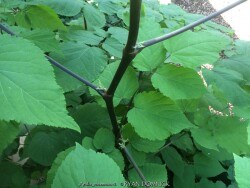

American Spikenard (Aralia racemosa) matures to 3-5' in height and has green flowers with attractive reddish purple berries in early fall. Spikenard is a true herbaceous perennial in that it dies back each fall and emerges from the ground up each spring. So large and broad, it is sometimes confused for a woodland shrub. It prefers wet to medium soil but tolerated dry-shade when mature in rich clay soils. Many woodland plants have already finished flowering when Spikenard blooms and shows off its beautiful berries. Cut the entire plant down in fall as there is no winter interest. In Kansas landscapes, use in Woodland gardens, sun dappled shade gardens, naturalized areas, wild gardens and native plant gardens. Plant as a specimen focal point or small grouping backdrop for shorter plants to contrast in the shade garden.
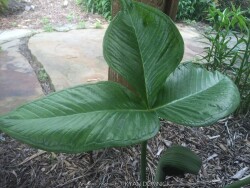

Japanese Cobra Lily (Arisaema ringens) is planted for its bright green foliage and bazaar "Cobra" hood-like flowers. Native to rich Japanese forests in humusy, medium to wet, well-drained soil in part shade to full shade, it needs a good location in the garden and will be a focal point. If foliage depreciates from drought, the plants may be cut to the ground with some regrowth and flowering possible in the fall. Combine with shade garden plants that will fill the space in summer such as hostas. Although this aroid offsetts, it is rare and uncommonly available for sale.


Dutchman's Pipe / Woolly Pipevine (Aristolochia tomentosa) is one of the most rapidly growing vines in out library capable of growing 15-30' in one summer! Native to eastern North America including Missouri, it typically occurs along moist woods and along streams. It can fill a large trellis or arbor with bright green foliage up to 12" across creating the most dense shade of any vine. It needs typical garden soil and regular moisture and is intolerant of drought. In Eastern Kansas, typically our 40 inches of rainfall is close to sufficient without much extra water if planted in good soils. The flowers are 1-2" across but are usually not noticed but is absolutely gorgeous with foliage alone.
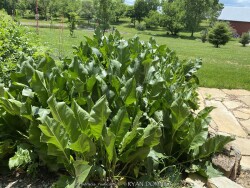

Horseradish (Armoracia rusticana) is a large tropical looking plant features large, variably sized 18-24" long, shiny, dark green leaves (resembling Silphium). It is also a perennial vegetable that is grown for its pungent, fleshy roots which are harvested and grated to make sauces. Insignificant, whitish flowers which appear in summer. Beware that this is an extremely vigorous plant that crowds out most weeds and is itself weed-like, with a very spreading growth habit. Best planted and allowed to grow as large isolated clumps, mowing around it generally stops the yearly spread. Included in our "edibles" plant database section.
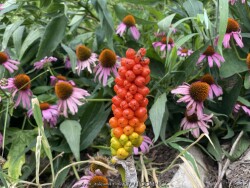

Italian Painted Arum (Arum italicum 'Pictum') is native to the Mediterranean region. It has a reversed or off-schedule life cycle; growing when other plants have already shed their leaves to take advantage of sunlight and lack of competition. It is often planted for its unusual evergreen leaf pattern and color resembling a bright green house plant growing outside in winter. Foliage goes dormant by June but is followed by naked stalks emerging from the ground with reddish orange berries. Foliage re-appears in fall and lasts well into winter untouched. If low temperatures hit 0 degrees F, foliage finally dies back to the ground and re-emerges in early spring to repeat the life cycle. If low temperatures hit -15 degrees F, it may kill an un-mulched plant; protect any zone 5/6 perennial with a 2-3" thick layer of mulch. Grow in average to rich well drained garden soil in full sun or full shade with everything in between. Moderate dry shade does not seem to be a problem because arum goes dormant anyways in the heat of summer. This holds true for planting in sunny locations to. Combine with shade garden plants that will fill the space in summer such as hostas or solomon seal. Also great when combined with late-emerging spring perennials (like plumbago, hardy hibiscus, and orange butterfly weed) because it fills that early spring space starting to grow extremely early with freeze-resistant foliage. Then later in the summer when Arum goes dormant, these plants hide the dying foliage and void left in the garden; what a great way for two species to share the same garden space! It has potential to be invasive in parts of the country such as the Pacific Northeast USA but not in Kansas. It is very stable but does not self-seed or spread in Lawrence, KS gardens; bulb offsets develop but only thicken the existing clump over time. Considered to be a great permatanet multi-season perennial for your garden.
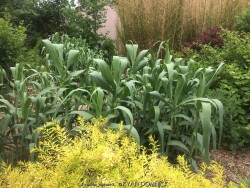

Giant Reed Grass (Arundo donax) is a giant perennial grass that can reach up to 20 ft. in height in Kansas in average to wet soils. Although it can be much shorter in full to part shade or very dry soils. The overall look is tropical like resembling giant corn. Flowering occurs in late summer to early fall, when plants are most easily recognized because of the large, dense flower plumes (upto 3' long) that develop at the tops of the culms. Arundo donax is native to India and spreads through rhizomes and stem nodes that come in contact with the soil. If low temperatures hit -10 degrees F, it may kill an un-mulched plant; protect any zone 6 perennial with thick layer of mulch. It has potential to be invasive in parts of the country but not so much in Kansas as cold winters prevent this plant from self-seeding and taking over ecosystems. Maintenance can be quite a yearly chore cutting back 20' tall cans each year; we recommend a chainsaw, heavy-duty loppers, and a large burn pit. Canes pop (but don't spark) when burning in bonfires! Make your very own firework sound effects; lots of fun with our kids! Cut-back is best in the fall because canes shed leaves stalks making a mess when winter winds blow. For the home garden, the species is generally too aggressive to mix with other plants or near the house: plan on its use as a screening plant and allow at least a 10'x10' area. One of the best plants for screening busy highways in rough non-irrigated areas.
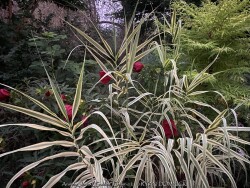

Golden Chain is a dwarf Giant Reed Grass cultivar (Arundo donax 'Golden Chain') is a perennial grass that can reach up to 8 ft. in height in Kansas in average to wet soils. Although it can be much shorter in part shade or very dry soils. The overall look is tropical like resembling corn. Flowering occurs in late summer to early fall, when plants are most easily recognized because of the large, dense flower plumes (upto 2' long) that develop at the tops of the culms. Arundo donax is native to India and spreads through rhizomes and stem nodes that come in contact with the soil. If low temperatures hit -10 degrees F, it may kill an un-mulched plant; protect any zone 6 perennial with thick layer of mulch. The non-variegated species has potential to be invasive in parts of the country but not so much in Kansas as cold winters prevent this plant from self-seeding and taking over ecosystems. Cut-back is best in the fall because canes shed leaves stalks making a mess when winter winds blow. Canes pop (but don't spark) when burning in bonfires! Make your very own firework sound effects; lots of fun with our kids! For the home garden, Golden Chain Dwarf Giant Reed Grass is much less aggressive than the species; you can mix it with other plants near the house or in rain gardens. Large clumps have been stable in our Lawrence, KS (zone 6a) display garden for over 5 years; spread is quite slow and manageable.
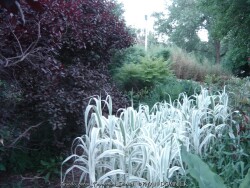

Golden Chain is a dwarf Giant Reed Grass cultivar (Arundo donax 'Golden Chain') This arundo cultivar (Arundo donax 'Peppermint Stick') is a perennial grass that can reach up to 12 ft. in height in Kansas in average to wet soils. Although it can be much shorter in full to part shade or very dry soils. The overall look is tropical like resembling giant corn. Flowering occurs in late summer to early fall, when plants are most easily recognized because of the large, dense flower plumes (upto 3' long) that develop at the tops of the culms. Arundo donax is native to India and spreads through rhizomes and stem nodes that come in contact with the soil. If low temperatures hit -10 degrees F, it may kill an un-mulched plant; protect any zone 6 perennial with thick layer of mulch. The non-variegated species has potential to be invasive in parts of the country but not so much in Kansas as cold winters prevent this plant from self-seeding and taking over ecosystems. Cut-back is best in the fall because canes shed leaves stalks making a mess when winter winds blow. Canes pop (but don't spark) when burning in bonfires! Make your very own firework sound effects; lots of fun with our kids! For the home garden, Peppermint Stick Giant Reed Grass is less aggressive than the species; you can mix it with other plants near the house or in rain gardens. Peppermint Stick maintains it's variegation unlike older variegated cultivars and does not revert or fade to green! Large clumps have been stable in our Lawrence, KS (zone 6a) display garden for over a decade; spread is quite slow and manageable.
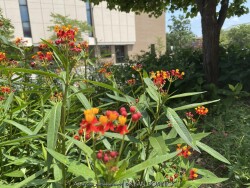

***Description for this plant available with future update!***
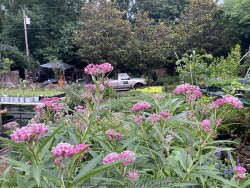

Pink Swamp Milkweed (Asclepias incarnata) is a herbaceous perennial plant species native to North America. The foliage is bright green and upright. The blooms occurring in early to mid-summer are pink to mauve (sometimes white). After blooming, green seed pods are attractive. They finally split open in late summer releasing silver fluffy floating seeds that are whisked away in the wind. This same natural mechanism for seed dispersal is similar to that used by most other milkweed (Asclepias) species. Fall color is an attractive yellow to gold with red highlights. It is frequently grown as a bog plant needing constantly moist soil rich in organic matter. As a rain garden plant, it will thrive is a depressed area in the landscape that collects rain water from a roof during spring and summer periods of rain but then go dormant if the water hole dries out completely. This species is not shade-tolerant and will get crowded out if the rain garden becomes too dense. Pink Swamp Milkweed may also be grown in average garden soils provided extra water is supplied during droughts. It is cultivated as a garden plant for butterflies and birds at all life stages: foliage for caterpillars, nectar for butterflies and other insects, and seeds for birds. It has a latex sap containing toxic chemicals that helps it repel other insects and other herbivorous animals. In the home landscape, this species does not spread like some other milkweeds. The plant is also timid about self-seeding because seeds have to germinate in mud and quickly die if it dries out. No worries about invasiveness with this one, just count on it being a beautiful tall perennial for many years in the garden! The species is not shade-tolerant and is not a good vegetative competitor.
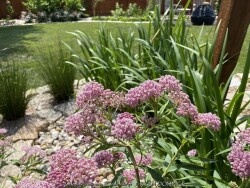

Pink Swamp Milkweed (Asclepias incarnata) is a herbaceous perennial plant species native to North America. The foliage is bright green and upright. The blooms occurring in early to mid-summer are pink to mauve (sometimes white). After blooming, green seed pods are attractive. They finally split open in late summer releasing silver fluffy floating seeds that are whisked away in the wind. This same natural mechanism for seed dispersal is similar to that used by most other milkweed (Asclepias) species. Fall color is an attractive yellow to gold with red highlights. It is frequently grown as a bog plant needing constantly moist soil rich in organic matter. As a rain garden plant, it will thrive is a depressed area in the landscape that collects rain water from a roof during spring and summer periods of rain but then go dormant if the water hole dries out completely. This species is not shade-tolerant and will get crowded out if the rain garden becomes too dense. Pink Swamp Milkweed may also be grown in average garden soils provided extra water is supplied during droughts. It is cultivated as a garden plant for butterflies and birds at all life stages: foliage for caterpillars, nectar for butterflies and other insects, and seeds for birds. It has a latex sap containing toxic chemicals that helps it repel other insects and other herbivorous animals. In the home landscape, this species does not spread like some other milkweeds. The plant is also timid about self-seeding because seeds have to germinate in mud and quickly die if it dries out. No worries about invasiveness with this one, just count on it being a beautiful tall perennial for many years in the garden! The species is not shade-tolerant and is not a good vegetative competitor.
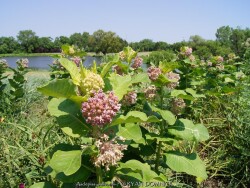

***Description for this perennial available with future update!***


***Description for this perennial available with future update!***
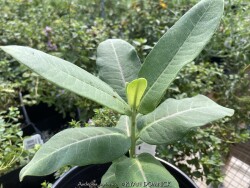

***Description for this perennial available with future update!***
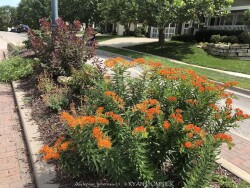

Orange Butterfly Milkweed (Asclepias tuberosa) is a native wildflower with bright orange flowers occurring mostly in dry open habitats and is very common in the prairies and grasslands of the Midwest and Great Plains. Common in Kansas, this beautiful native wildflower is also found from Maine to South Dakota to the desert southwest to Florida. In ideal locations established Butterfly Weeds are very showy with multiple flowering stems spreading across the two foot high plant. Mature plants also have a deep tap root that extends down a foot or more allowing them superb drought tolerance. This rugged species thrives in sunny locations, in dry sandy soil or well-drained loam. More permanent locations include limestone bluffs, rocky prairies, and Great Plains. This wildflower also colonizes readily with wind blown fluffy seeds and will grow under the mower blades sometimes completing their flowering before yearly mowing along state highways. Foliage is often green, upright and attractive. Flowering is long lasting usually 4-6 weeks with interesting seed pods developing later. These eventually open and seeds float away. Reseeding is rare in the garden as mulch will generally eliminate that possibility. In the landscape, Orange Butterfly Weed can be used in any dry soil situation including berms, hot south or west side of the house, or any other full sun area. These will grow in poor rocky, sandy or clayish soils and even rich organic soils as a beautiful flowering annual. With our average 40 inches of rain per year in eastern Kansas, extra irrigation is not recommended. When used as an annual with irrigation and rich garden soil, you can expect the amazing growth and summer flowering followed by a probable root rot in the winter. Orange Butterfly Weed can be planted in parking lot medians and other hell strips as a very durable groundcover. Orange Butterfly Weed can also thrive in an above-ground perennial planter (with appropriate potting soil) year-round surviving the winter coldness in Eastern Kansas (zone 6a/5b). In any situation, combine with any other flower colors except orange. There is quite a lot of diversity within the species so plants from different locales will have different foliage and flower shades adapted to the site. Flower color can range from almost red to pure yellow and everything in between.
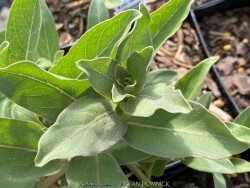

***Description for this perennial available with future update!***
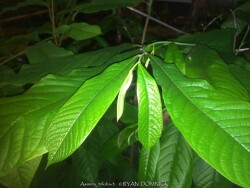

Paw Paw (Asimina triloba) is a tropical looking native understory fruit tree with large green leaves and delicious fruits. Flowers are born on old wood in the early spring and the maroon color is common of flowers meant to attract flies for pollination. Foliage is up to 12 inches long and turns a brilliant yellow in autumn for a couple weeks before falling. If cross pollination occurs, delicious fruits are produced in small clusters. The texture is custard like and taste is a mix between banana, mango, and hint of pineapple. Fruit is very fragile upon ripening and will fall to the ground and splat or be quickly devoured by animals. It is suggested that you put fruit nets around the clusters of fruit or harvest a few days earlier and allow to ripen inside. Fruit is rarely commercially available due to its fragility and short shelf-life. Cleaned fruit may be peeled frozen with seed intact: they can be picked out much easier when thawed out again Paw Paw may be eaten fresh, baked into desserts, or made into ice cream. Paw Paw is native to a large geographical area over eastern United States including Kansas. In the wild, Paw Paw grows in moist rich forest valleys in full to part shade. Best fruiting specimens can also be found on the edge of woodland or clearing in rich soil. Paw Paw tree colonies slowly spread by rhizomes and seem to occupy the forest understory sometimes for decades or centuries waiting for an opening to allow sunlight in. If a large canopy tree (such as an oak) dies or wind storm rolls through clearing a patch, new sunlight and an opening in the canopy occurs paving the way for sexual reproduction to take place (fruits) Paw Paw is somewhat tolerant of poorly drained soil's including clay but growth will be much slower. Interestingly, Paw Paws will tolerate and even need full sun when older to produce fruit. However, young saplings will quickly die in full sun from leaf burn and drought stress. If a tree is at least 4 to 6 tall and is planted in rich soil and full sun with regular irrigation, it will probably be fine. With these growing conditions, trees may grow at a median growth rate instead of slow, putting up 1 to 2 feet of new growth per year. If you have the right conditions for a Paw Paw tree, it should definitely be a part of your landscape whether you are growing for fruit production or not. There are dozens on improved cultivars available now days. In our Lawrence, KS display gardens, we are trialing several of these improved fruiting cultivars from Forrest Keeling Nursery in Missouri.


Paw Paw (Asimina triloba) is a tropical looking native understory fruit tree with large green leaves and delicious fruits. Flowers are born on old wood in the early spring and the maroon color is common of flowers meant to attract flies for pollination. Foliage is up to 12 inches long and turns a brilliant yellow in autumn for a couple weeks before falling. If cross pollination occurs, delicious fruits are produced in small clusters. The texture is custard like and taste is a mix between banana, mango, and hint of pineapple. Fruit is very fragile upon ripening and will fall to the ground and splat or be quickly devoured by animals. It is suggested that you put fruit nets around the clusters of fruit or harvest a few days earlier and allow to ripen inside. Fruit is rarely commercially available due to its fragility and short shelf-life. Cleaned fruit may be peeled frozen with seed intact: they can be picked out much easier when thawed out again Paw Paw may be eaten fresh, baked into desserts, or made into ice cream. Paw Paw is native to a large geographical area over eastern United States including Kansas. In the wild, Paw Paw grows in moist rich forest valleys in full to part shade. Best fruiting specimens can also be found on the edge of woodland or clearing in rich soil. Paw Paw tree colonies slowly spread by rhizomes and seem to occupy the forest understory sometimes for decades or centuries waiting for an opening to allow sunlight in. If a large canopy tree (such as an oak) dies or wind storm rolls through clearing a patch, new sunlight and an opening in the canopy occurs paving the way for sexual reproduction to take place (fruits) Paw Paw is somewhat tolerant of poorly drained soil's including clay but growth will be much slower. Interestingly, Paw Paws will tolerate and even need full sun when older to produce fruit. However, young saplings will quickly die in full sun from leaf burn and drought stress. If a tree is at least 4 to 6 tall and is planted in rich soil and full sun with regular irrigation, it will probably be fine. With these growing conditions, trees may grow at a median growth rate instead of slow, putting up 1 to 2 feet of new growth per year. If you have the right conditions for a Paw Paw tree, it should definitely be a part of your landscape whether you are growing for fruit production or not. There are dozens on improved cultivars available now days. In our Lawrence, KS display gardens, we are trialing several of these improved fruiting cultivars from Forrest Keeling Nursery in Missouri. Asimina triloba 'Mango' features exceptionally large fruit with flavorful yellow flesh. This has the most vigorous growth of pawpaw varieties. Fruit is late ripening.
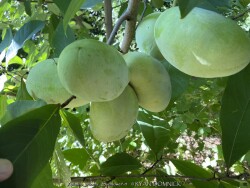

Paw Paw (Asimina triloba) is a tropical looking native understory fruit tree with large green leaves and delicious fruits. Flowers are born on old wood in the early spring and the maroon color is common of flowers meant to attract flies for pollination. Foliage is up to 12 inches long and turns a brilliant yellow in autumn for a couple weeks before falling. If cross pollination occurs, delicious fruits are produced in small clusters. The texture is custard like and taste is a mix between banana, mango, and hint of pineapple. Fruit is very fragile upon ripening and will fall to the ground and splat or be quickly devoured by animals. It is suggested that you put fruit nets around the clusters of fruit or harvest a few days earlier and allow to ripen inside. Fruit is rarely commercially available due to its fragility and short shelf-life. Cleaned fruit may be peeled frozen with seed intact: they can be picked out much easier when thawed out again Paw Paw may be eaten fresh, baked into desserts, or made into ice cream. Paw Paw is native to a large geographical area over eastern United States including Kansas. In the wild, Paw Paw grows in moist rich forest valleys in full to part shade. Best fruiting specimens can also be found on the edge of woodland or clearing in rich soil. Paw Paw tree colonies slowly spread by rhizomes and seem to occupy the forest understory sometimes for decades or centuries waiting for an opening to allow sunlight in. If a large canopy tree (such as an oak) dies or wind storm rolls through clearing a patch, new sunlight and an opening in the canopy occurs paving the way for sexual reproduction to take place (fruits) Paw Paw is somewhat tolerant of poorly drained soil's including clay but growth will be much slower. Interestingly, Paw Paws will tolerate and even need full sun when older to produce fruit. However, young saplings will quickly die in full sun from leaf burn and drought stress. If a tree is at least 4 to 6 tall and is planted in rich soil and full sun with regular irrigation, it will probably be fine. With these growing conditions, trees may grow at a median growth rate instead of slow, putting up 1 to 2 feet of new growth per year. If you have the right conditions for a Paw Paw tree, it should definitely be a part of your landscape whether you are growing for fruit production or not. There are dozens on improved cultivars available now days. In our Lawrence, KS display gardens, we are trialing several of these improved fruiting cultivars from Forrest Keeling Nursery in Missouri. Asimina triloba 'Sunflower' is a well-known, hardy selection originally from Chanute, Kansas. It ripens later than other varieties with large, flavorful fruit and is at lease partially self-fertile. Fruit has been described as tasting of mango, apricot, pineapple, banana and vanilla.
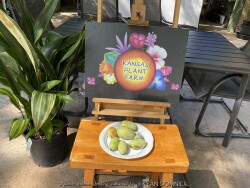

Paw Paw (Asimina triloba) is a tropical looking native understory fruit tree with large green leaves and delicious fruits. Flowers are born on old wood in the early spring and the maroon color is common of flowers meant to attract flies for pollination. Foliage is up to 12 inches long and turns a brilliant yellow in autumn for a couple weeks before falling. If cross pollination occurs, delicious fruits are produced in small clusters. The texture is custard like and taste is a mix between banana, mango, and hint of pineapple. Fruit is very fragile upon ripening and will fall to the ground and splat or be quickly devoured by animals. It is suggested that you put fruit nets around the clusters of fruit or harvest a few days earlier and allow to ripen inside. Fruit is rarely commercially available due to its fragility and short shelf-life. Cleaned fruit may be peeled frozen with seed intact: they can be picked out much easier when thawed out again Paw Paw may be eaten fresh, baked into desserts, or made into ice cream. Paw Paw is native to a large geographical area over eastern United States including Kansas. In the wild, Paw Paw grows in moist rich forest valleys in full to part shade. Best fruiting specimens can also be found on the edge of woodland or clearing in rich soil. Paw Paw tree colonies slowly spread by rhizomes and seem to occupy the forest understory sometimes for decades or centuries waiting for an opening to allow sunlight in. If a large canopy tree (such as an oak) dies or wind storm rolls through clearing a patch, new sunlight and an opening in the canopy occurs paving the way for sexual reproduction to take place (fruits) Paw Paw is somewhat tolerant of poorly drained soil's including clay but growth will be much slower. Interestingly, Paw Paws will tolerate and even need full sun when older to produce fruit. However, young saplings will quickly die in full sun from leaf burn and drought stress. If a tree is at least 4 to 6 tall and is planted in rich soil and full sun with regular irrigation, it will probably be fine. With these growing conditions, trees may grow at a median growth rate instead of slow, putting up 1 to 2 feet of new growth per year. If you have the right conditions for a Paw Paw tree, it should definitely be a part of your landscape whether you are growing for fruit production or not. There are dozens on improved cultivars available now days. In our Lawrence, KS display gardens, we are trialing several of these improved fruiting cultivars from Forrest Keeling Nursery in Missouri.
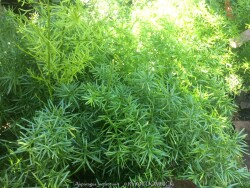

***Description for this plant available with future update!***
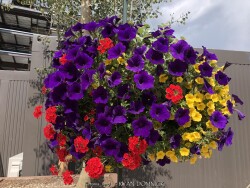

Assorted Annual Flowering Hanging Baskets offer intense color to the patio or pergola!
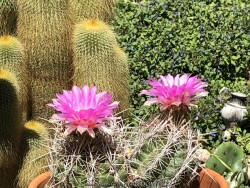

Succulents are usually spineless and grown for their beautiful shapes, color and texture. Cactus are known for their spines, unusual shapes and beautiful flowers. Late on the evolutionary timeline, cacti fossils are rare to non-existent. The "spines" are actually modified leaves! Cacti are native almost exclusively to the Americas, while succulents can include a much larger plant palette be from any dry area in the world. Both succulents and cacti store water in their fleshy tissues. They are usually grown as a patio or house plant in Kansas. In the wild, some species are hardy to below 0 degrees F. Grow in full sun with no extra watering except that which comes from rainfall. Repotting may or may not be needed depending on how large you want the plant to grow; plants can continue to grow taller and tolerate extremely root-bound pots but may need wind bracing. If repotting, make sure to use a sharp draining low organic cactus mix with plenty of sand and perlite. To play is safe, potted plants are best moved in before night temperatures get below 45 degrees F. It is important to avoid the combination of wet and cold. Move to a bright interior window over the winter with no watering and keep above freezing. As a winter house plant, it will look presentable all winter long with just no waterings. As a permanent house plant, provide bright light and allow the soil to dry between waterings for many years of carefree enjoyment. Plants grown permanently indoors may begin to elongate stretching for light and lose their spine color. It can be hard to reproduce the intense UV sunlight they need so moving outside for the summer is best. Generally if moving outside for the summer, allow 1-2 weeks of part shade or morning sun before placing in full sun. Plants with time to acclimate will thrive in full sun but be careful not to rush it or sunburning will occur. Potted plants are very low maintenance but watch for scale and mealybugs that may hide beneath the cover of spines.